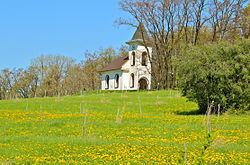Time zone CET (UTC+1) Area 14.27 km² Population 130 (2011) | Elevation 256 m Local time Saturday 9:15 AM | |
 | ||
Weather 8°C, Wind NW at 13 km/h, 66% Humidity | ||
Rusín (German: Rausen) is a village and municipality in Bruntál District in the Moravian-Silesian Region of the Czech Republic. Rusín is a municipality first mentioned in 1262, lying at the easternmost corner of Osoblažsko region. Nowadays it has a population of 150 inhabitants in three local districts – Rusín, Hrozová and Matějovice.
Map of 793 97 Rus%C3%ADn, Czechia
The village is dominated by the Chapel of the Virgin Mary, located on the Rusin hill (314 m.s.l.) mainly due to its location and importance for Czech – Polish and German relations. The chapel with the same name stood there since 1814 but it was destroyed by heavy bombardment at the end of World War II. It was replaced with a replica constructed in 1992-1993 by the impulse of Professor Joseph Scharbert, professor of the theological faculty of Munich University (by the way a classmate of the present pope Benedict XVI) and a native of Hrozová. Approximately 600 Czechs, Poles and Germans took part in the opening ceremony of the replica chapel on 8 August 1993 and today it is an important pilgrimage place of interest not only for believers but also for tourists as they may enjoy outstanding views from the top of the hill where it is situated. Another way how to spend a free afternoon is to plan a trip from Rusín to the nearby historical city of Glubczyce in Poland or just to exercise or relax in a recently newly built sports complex with multifunctional ground.
Even Hrozová has things to offer – in addition to its lovely rural character there is the Church of St. Michael the Archangel which is a great attraction for tourists. The church was established probably at the end of the 13th century when the interior gothic was realised. There is one more interesting thing about the church as it is surrounded by a defensive wall from the 15-16th centuries which explains its massive construction. In case of a raid by foreign troops this was the place where local residents took shelter. Hrozová is also home of the civic association „Královský stolec“ which has significantly contributed to the development of cultural life and rediscovering forgotten traditions of Osoblažsko region. Restoration of the tradition of bonelace, crosses near the road or an investigation of so-called „Hrozovská Madonna“ from the 16th century together with the creation of her copy belongs to its most important achievements (The Madonna may be seen in Hrozová chapel).
There is also a pseudokarst cave located in the sandstone rock on the right bank of the Hrozová stream close to Matějovice which is unfortunately inaccessible with 11 and 23 metres long and up to 4 metres high passages.
